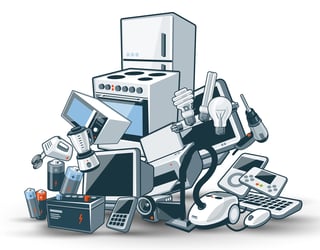On Sunday, April 22nd the world celebrates Earth Day – a holiday dedicated to the education and support of environmental issues and protection. From an IT perspective, although the rapid increase in electronics has created a growing stream of used devices in need of appropriate management, there are safe and responsible ways to get rid of old, retired electronics...
What began as a way to raise public awareness of air and water pollution, has become the “largest secular civic event in the world” with more than one billion people involved in Earth Day activities. Earth Day is celebrated globally and sometimes extended into “Earth Week,” a full seven days of events focused on green awareness.
Earth Day started in 1970 by Senator Gaylord Nelson with the aim of creating a movement to bring environmental causes into the national spotlight. Earth Day went global in 1990 and has grown significantly with 200 million people in over 140 nations participating according to the Earth Day Network (EDN), a nonprofit organization that coordinates Earth Day activities. Today, the EDN collaborates with more than 17,000 partners and organizations in 174 countries.
Recognizing the Importance of Earth
Besides for being the only one we got, the statistics on pollution and waste are staggering. You may want to sit down before reading the following, but here are a few we pulled from a TIME for Kids online article on Earth Day:*
Energy & Waste
- The average American produces more than four pounds of garbage per day and more than 1,600 pounds over the course of one year.
- Almost half of the food in the U.S. goes to waste—approximately 3,000 pounds per second.
- The U.S. wastes 30-40% of its food supply, more than 20 pounds of food per person every month.
Plastic, Glass & Paper
- Every year, Americans throw away enough paper and enough plastic cups, forks, and spoons to circle the equator 300 times.
- About 14% of all litter comes from beverage containers and it takes about 450 years for plastic, and one million years for glass, bottles to break down in a landfill.
- Americans use about 69 million tons of paper and paperboard each year.
Water & Oceans
- Only 1% of the world’s water is usable for agriculture, manufacturing, and personal needs. (Nearly 97% of the world's water is salty or otherwise undrinkable. Another 2% is locked in ice caps and glaciers.)
- The average American family uses about 300 gallons of water per day and more than 100,000 gallons of water per year.
- There are about 245,000 metric tons of floating plastic trash in the world's oceans, and about 8 million metric tons of plastic is added each year.
- Every square mile of the oceans contains more than 46,000 pieces of floating plastic.
How Earth Day, E-waste and Technology Connect
Electronic waste, or e-waste, are products like TVs, refrigerators, computers, tablets, and cell phones that are no longer in use, work, are unwanted or have reached their end of life. Since the creation of technological advancements have increasingly accelerated as their lifespans have steadily decreased, outdated and obsolete appliances, devices and portable electronics are ending up in unsafe places at an alarming rate. In fact...
...IT equipment has become the number one source of toxins at area landfills due to the potentially harmful materials and chemicals found in many of these devices.
The truth is, the rapid increase in electronics has created a growing stream of used devices in need of appropriate management.
It is also important to note that the production of new electronic devices require a significant amount of resources to make, with many of the same materials recoverable through recycling. According to the US EPA, only 25% of discarded computers, printers, copiers and mobile devices are collected and properly recycled – with the rest ending up in landfills and incinerators. Improperly recycled e-waste can put our waterways, soil, and air at risk -- endangering human health and the environment if not handled properly.
The 3R’s (Recycle, Reduse, Reuse)!
What can we do? Start following the 3R's – Recycle, Reduce, Reuse. More than 70% of collected electronics can be reused, repurposing items such as plastics, steel, aluminum, copper, gold, silver and other precious metals. According to the US EPA, “The recycling rate has increased from less than 10% in 1980 to more than 34.3% in 2013" which is a great start. By recycling, organizations can do their part to preserve the environment for future generations. Here are some more great stats and facts to consider*:
- The energy saved by recycling one plastic bottle can power a computer for 25 minutes.
- The energy saved from recycling one glass bottle will operate a 100-watt light bulb for four hours.
- Producing glass from new materials requires 30% more energy than using already-used glass.
- Preventing one ton of paper waste saves between 15 and 17 mature trees.
- By recycling 1 ton of paper, we save enough energy to heat a home for six months.
Let's Get Started...
Lantium offers safe and responsible ways to get rid of old, retired electronics and we accept a broad range of items for disposal and recycling. ALSO, please remember never just toss out old hard drives, erase them, or stockpile them in storage. Physically destroying your hard drives is the only way to ensure information is unrecoverable, safe and compliant.
Interested in learning more about responsible ways to recycle your organization's e-waste as well as proper data destruction services?
LANTIUM, Greater Philadelphia technology experts serving organizations of all industries, can help you go green from an IT perspective and more. Click below to learn more and schedule a free call with our experienced consultants today!
*SOURCES: Environmental Protection Agency, Associated Press, Clean Air Council, Recycle Across America, World Food Day, The Water Information Program, PLOS, National Geographic, Waterinfo.org




